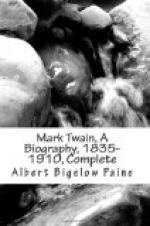Florida, Missouri, was a small village in the early thirties—smaller than it is now, perhaps, though in that day it had more promise, even if less celebrity. The West was unassembled then, undigested, comparatively unknown. Two States, Louisiana and Missouri, with less than half a million white persons, were all that lay beyond the great river. St. Louis, with its boasted ten thousand inhabitants and its river trade with the South, was the single metropolis in all that vast uncharted region. There was no telegraph; there were no railroads, no stage lines of any consequence—scarcely any maps. For all that one could see or guess, one place was as promising as another, especially a settlement like Florida, located at the forks of a pretty stream, Salt River, which those early settlers believed might one day become navigable and carry the merchandise of that region down to the mighty Mississippi, thence to the world outside.
In those days came John A. Quarles, of Kentucky, with his wife, who had been Patsey Ann Lampton; also, later, Benjamin Lampton, her father, and others of the Lampton race. It was natural that they should want Jane Clemens and her husband to give up that disheartening east Tennessee venture and join them in this new and promising land. It was natural, too, for John Quarles—happy-hearted, generous, and optimistic—to write the letter. There were only twenty-one houses in Florida, but Quarles counted stables, out-buildings—everything with a roof on it—and set down the number at fifty-four.
Florida, with its iridescent promise and negligible future, was just the kind of a place that John Clemens with unerring instinct would be certain to select, and the Quarles letter could have but one answer. Yet there would be the longing for companionship, too, and Jane Clemens must have hungered for her people. In The Gilded Age, the Sellers letter ends:
“Come!—rush!—hurry!—don’t wait for anything!”
The Clemens family began immediately its preparation for getting away. The store was sold, and the farm; the last two wagon-loads of produce were sent to Louisville; and with the aid of the money realized, a few hundred dollars, John Clemens and his family “flitted out into the great mysterious blank that lay beyond the Knobs of Tennessee.” They had a two-horse barouche, which would seem to have been preserved out of their earlier fortunes. The barouche held the parents and the three younger children, Pamela, Margaret, anal the little boy, Benjamin. There were also two extra horses, which Orion, now ten, and Jennie, the house-girl, a slave, rode. This was early in the spring of 1835.
They traveled by the way of their old home at Columbia, and paid a visit to relatives. At Louisville they embarked on a steamer bound for St. Louis; thence overland once more through wilderness and solitude into what was then the Far West, the promised land.




